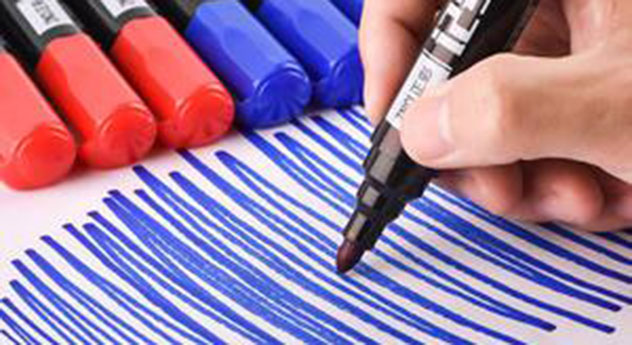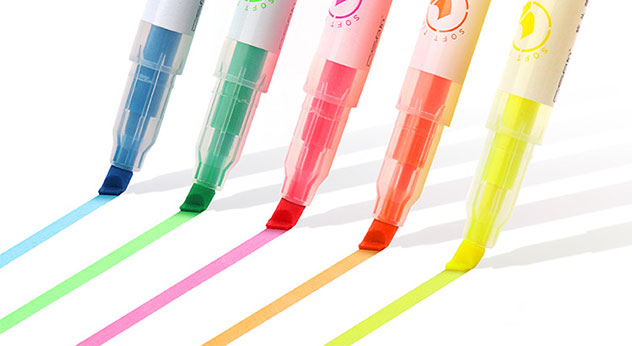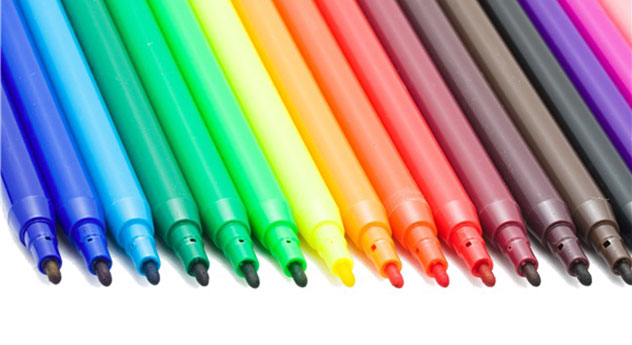Marker pen is a pen that can write marks or signs on one or more materials such as paper, wood, metal, plastic, and ceramic. Usually we divide the marker pens into oil-based marker pens and water-based marker pens. Water-based markers can write on smooth surfaces or whiteboards, and can be wiped off with a rag (whiteboard markers), and oil-based markers are not easy to erase.
There are several categories of markers:
1)Permanent marker
Use oil-based ink for writing, suitable for marker pens on various writing surfaces.
2) Water-base ink marker
Use water-based ink for writing, mainly used for marker pens on the surface of paper.

3) Marker pen for whiteboard
A marker pen that can be used to write on the surface of whiteboards or swatches such as enamel, baking paint, and plastic paste, and the handwriting is easy to erase.
4) Highlighter-also named as fluorescent pen, high lighter.
A marker pen that contains fluorescent materials in the writing medium to make eye-catching marks or signs. Common colors include fluorescent yellow, lemon yellow, lavender, light pink, green, sky blue, etc.

5)Color ink pen
A complete set of pens filled with water-based inks of different colors, mainly used for drawing or marking marker pens.

6) Signature pen
The extruded plastic microporous pen tip is used for signature and general writing markers.
What are the main components of the ink in the marker? Let's analyze it below:
1. Pigment
Including pigments and dyes. Pigments are divided into organic pigments and inorganic pigments. The former has bright color and strong coloring power, and is widely used in inks, such as azo and phthalocyanine pigments; the latter has light resistance, heat resistance, and solvent resistance , The hiding power is better, such as titanium white, cadmium red, chrome green, ultramarine blue and so on. Pigments are colored in the form of particles and do not dissolve. They are the most commonly used colorants in inks. While the dye is formulated into a solution when in use, it is colored in a molecular state, and the effect is not as good as that of a pigment. The pigment can give the ink different colors and color density, and make the ink have a certain viscosity and dryness.
2. Connecting materials.
It is also one of the main components of ink, which acts as a medium for dispersing pigments and auxiliary materials. It is made by dissolving a small amount of natural resin, synthetic resin, cellulose, rubber derivatives, etc. in dry oil or solvent. It has certain fluidity, so that the ink forms a uniform thin layer after printing, and forms a film with a certain strength after drying. It also protects the pigment and makes it difficult to fall off.
The binder has a great influence on the transferability, brightness, fixing speed and other printing suitability and printing effect of the ink. Therefore, choosing the right binder is one of the keys to ensure good printing. It should be based on packaging materials, printing requirements, etc. Different, adjust the composition and ratio of the binder at any time.
3. Ink auxiliary components
There are many auxiliary components of ink, mainly as follows:
① Filler. It is an additive to adjust the ink concentration, and it can also increase the thickness of the ink film and improve its wear resistance. It has no tinting power and hiding power. Mainly include barium sulfate, calcium carbonate, aluminum hydroxide, etc., which are crushed into white powder when used.
② Thinner. Its function is to reduce the viscosity of the ink, prevent the phenomenon of film peeling, and make the ink workable. Commonly used diluents are oligomerized linseed oil and mineral oil. The former is easy to mix with ink and has a soft effect; the latter has obvious dilution effect, but avoid excessive printing, otherwise the printing effect will be bad.
③ Anti-skinning agent. Its function is to inhibit the drying speed of the ink and prevent the ink from drying and conjunctivating mechanically. Its main ingredients are organic reducing agents and antioxidants. It can be added to the ink, or it can be spread on the machine in contact with the ink.
④Anti-reverse printing agent. Its function is to prevent the printing ink layer from being reversed to the back of the paper to ensure printing quality. The most commonly used anti-offset agent is corn starch.
⑤ Slip agent. Its function is to improve the friction resistance and fluidity of the ink, reduce the viscosity, improve the smoothness of the film, and reduce the phenomenon of paper fuzzing. Commonly used slip agents in inks include high melting point microcrystalline wax and synthetic wax.
⑥ Other additives. There are many other additives, such as dispersing agents, wetting agents, desiccants, and stabilizers.